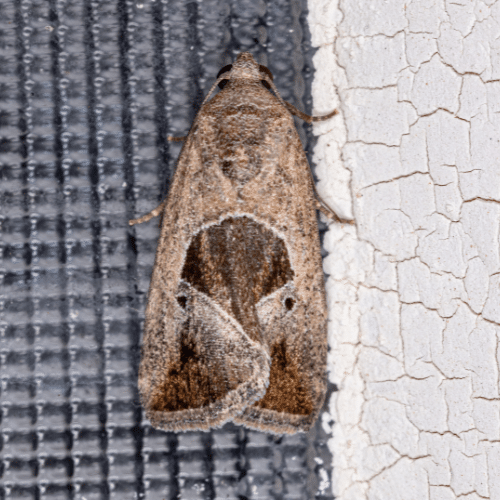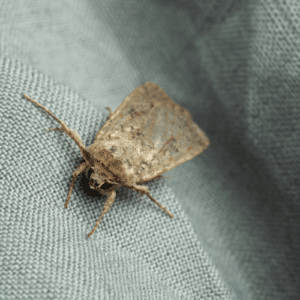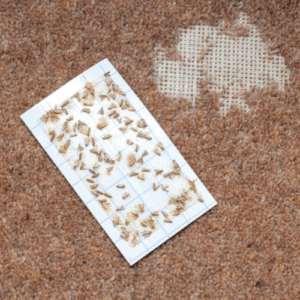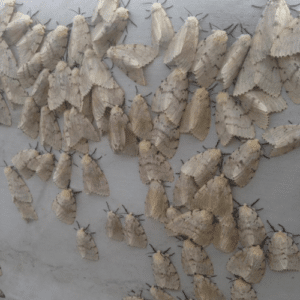
08 Oct Protect Clothes Prevent Moth Infestation
Wardrobe Protection from Moths
Moths might seem like harmless little insects fluttering around, but when they find their way into your closet, they can become a serious problem. Often overlooked, moths can cause significant damage to your clothes, especially items made from natural fibers like wool, silk, and cotton. For South Florida residents, the warm, humid climate can make closets an inviting space for moths to thrive. Left untreated, a moth infestation can destroy valuable clothing and fabric, making early detection and prevention essential.
As a family-owned, organic pest control company, Pest Busterzz understands how frustrating and costly it can be to deal with moths in your home. In this guide, we’ll explore how moths invade closets, the signs of infestation, the damage they can cause, and effective ways to prevent and treat moth infestations.
Moth Larvae: Hidden Closet Threat
There are several types of moths, but the ones that pose the most danger to your closet are clothes moths. The most common culprits include the Webbing Clothes Moth and the Case-Bearing Clothes Moth. Both of these species are known for targeting natural fibers, making them a threat to clothing, carpets, and other fabric items. These moths don’t eat your clothes themselves, but their larvae do.
It’s important not to confuse clothes moths with pantry moths, which are more interested in food storage areas. However, both can cause issues in your home. Understanding which type of moth you’re dealing with will help you choose the right treatment and prevention methods.
Moths are particularly attracted to natural fibers such as wool, silk, cotton, and even fur. These materials contain keratin, a protein that moth larvae feed on. Closets often provide the ideal environment for moths to thrive: they are dark, undisturbed, and often warm—perfect conditions for larvae to grow and develop.
Moths typically lay eggs directly on fabric, and once the eggs hatch, the larvae begin feeding. Since most of this activity occurs in dark, hidden areas, the damage often goes unnoticed until it’s too late. This makes closets a prime target for moth infestations, especially in regions like South Florida, where the weather is conducive to pest activity year-round.
Early Clues of Closet Moths
One of the most obvious signs of a moth infestation is finding holes in your clothing. Moths prefer natural fibers, so items made from wool, silk, and cashmere are often the first to show signs of damage. You may notice irregular holes in sweaters, scarves, or blankets that haven’t been worn or used for a while. Along with the holes, you might see small, silky webbing on the fabric or in the corners of your closet.
If the infestation is severe, you might also spot larvae in the folds of your clothing. These tiny, creamy-white caterpillar-like insects are the real culprits behind the damage. Adult moths are more visible, but it’s the larvae that do the feeding. Keeping an eye out for these warning signs can help you catch an infestation before it spreads.
Not all signs of a moth infestation are easy to see. Sometimes, you may notice a musty odor in your closet or on your clothes, which can be another indicator that moths are present. Moth larvae can create this unpleasant smell as they feed on fabrics, particularly natural fibers.
You may also feel that your clothes are weakening or becoming more fragile without any obvious signs of wear. Moth larvae can weaken fabric fibers over time, making clothes feel thinner and less durable. This damage might not be immediately visible, but it can become apparent when clothes start to tear more easily or develop holes in unexpected places.
Prevent Costly Moth Damage
While adult moths fluttering around may seem like the problem, it’s actually the larvae that do the real damage. Moth larvae are hatched from eggs laid directly on natural fibers. Once they emerge, the larvae feed on the keratin protein found in fabrics like wool, cashmere, and silk. The larvae can continue to feed for weeks, making the damage progressively worse if left untreated.
The cycle repeats as adult moths lay more eggs, which hatch into new larvae, continuing the destructive process. Because larvae often hide in the folds of clothing or in dark corners, they can be difficult to spot until they’ve caused significant damage.
Moths may seem like a minor annoyance, but the long-term impact of an infestation can be devastating. Clothes made from natural fibers are particularly vulnerable, and moth larvae can destroy expensive or sentimental items that are difficult, if not impossible, to replace. Holes caused by larvae are often irregular in shape and scattered across the fabric, making repairs difficult. In some cases, clothes may be damaged beyond repair.
Beyond the immediate damage, an untreated infestation can spread quickly. If moths are allowed to continue laying eggs, the larvae will keep feeding, causing more damage over time. That’s why it’s so important to address a moth infestation as soon as you notice the signs.
Stop Moths with Clean Closets
One of the best ways to prevent moth infestations is through regular closet maintenance. Moths thrive in undisturbed, cluttered spaces, so keeping your closet organized can help deter them. Vacuum your closet regularly, paying special attention to the floor, corners, and any areas where clothes are stored. This will help remove any eggs or larvae that may be hiding.
It’s also important to air out your clothes from time to time, especially items that aren’t worn frequently. Moths are more likely to target items that have been sitting in the closet for long periods. By keeping your closet well-ventilated and free from moisture, you reduce the likelihood of a moth infestation.
Proper storage is key to protecting your clothes from moths. For seasonal or valuable clothing items, consider using airtight containers or garment bags. These will help prevent moths from getting to your clothes. If possible, use garment bags made from natural materials like cotton, which allow airflow while still offering protection.
Another helpful tip is to avoid leaving dirty clothes in your closet, as moths are attracted to sweat and body oils left on fabrics. Always clean your clothes before storing them, especially if you won’t be wearing them for a while.
Keep Moths Away Naturally
Natural repellents like cedar chips, lavender sachets, and essential oils offer an effective way to keep moths out of your closet without chemicals. Cedar is well-known for its moth-repelling properties, while lavender not only deters moths but also keeps clothes smelling fresh. Refresh these natural repellents regularly to ensure they stay effective.
If you discover a moth infestation, there are several steps you can take on your own. Start by washing or dry cleaning affected clothes, as heat kills larvae and eggs. Vacuum your closet thoroughly, paying attention to corners and crevices, and use a steam cleaner on carpets and furniture. Discard the vacuum contents outside to prevent reinfestation.
For severe infestations, professional pest control may be needed. Pest Busterzz offers targeted treatments that eliminate moths at all life stages using eco-friendly, organic solutions. If DIY methods fail or the infestation is widespread, professional help can prevent further damage and provide long-term solutions.
Ongoing prevention is key to avoiding future infestations. Regularly inspect your closet for signs of moths and rotate your wardrobe to prevent larvae from settling. Professional services like Pest Busterzz can provide annual inspections and treatments to protect your home and belongings from moths and other pests.
Conclusion
Moths may be small, but the damage they can cause to your wardrobe is anything but insignificant. If left unchecked, these silent pests can destroy valuable clothing and fabrics, leaving you with costly repairs or replacements. Preventing and treating moth infestations is essential to protecting your home and wardrobe.
By maintaining a clean, organized closet, using proper storage techniques, and incorporating natural repellents, you can reduce the risk of moth infestations. If an infestation does occur, quick action and professional pest control can prevent further damage. At Pest Busterzz, we’re here to help protect your
home and your wardrobe from moths and other pests. Contact us today to learn more about our eco-friendly pest control solutions and how we can keep your home pest-free.






No Comments